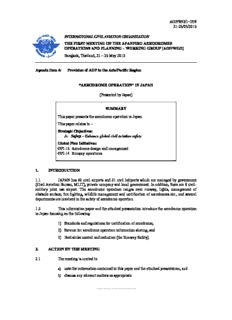
aop/wg/1−ip/6 21-23/05/2013 international civilaviation organization the first meeting of the ... PDF
Preview aop/wg/1−ip/6 21-23/05/2013 international civilaviation organization the first meeting of the ...
AOP/WG/1−IP/6 21-23/05/2013 INTERNATIONAL CIVIL AVIATION ORGANIZATION THE FIRST MEETING OF THE APANPIRG AERODROMES OPERATIONS AND PLANNING – WORKING GROUP (AOP/WG/1) Bangkok, Thailand, 21 – 23 May 2013 Agenda Item 4: Provision of AOP in the Asia/Pacific Region “AERODROME OPERATION” IN JAPAN (Presented by Japan) SUMMARY This paper presents the aerodrome operation in Japan. This paper relates to – Strategic Objectives: A: Safety – Enhance global civil aviation safety Global Plan Initiatives: GPI-13 Aerodrome design and management GPI-14 Runway operations 1. INTRODUCTION 1.1 JAPAN has 90 civil airports and 21 civil heliports which are managed by government (Civil Aviation Bureau, MLIT), private company and local government. In addition, there are 8 civil- military joint use airport. The aerodrome operation ranges over runway, lights, management of obstacle surface, fire fighting, wildlife management and certification of aerodromes etc., and several departments are involved in the safety of aerodrome operation. 1.2 This information paper and the attached presentation introduce the aerodrome operation in Japan focusing on the following: 1) Standards and regulations for certification of aerodrome; 2) Service for aerodrome operation information sharing; and 3) Bird strike control and reduction (for Runway Safety). 2. ACTION BY THE MEETING 2.1 The meeting is invited to: a) note the information contained in this paper and the attached presentation; and b) discuss any relevant matters as appropriate. …………………………. Aerodrome Operation in JAPAN THE FIRST MEETING OF THE APANPIRG AERODROMES OPERATIONS AND PLANNING – WORKING GROUP (AOP/WG/1) Bangkok, Thailand, 21 – 23 May 2013 Takahiro TOKUI Civil Aviation Bureau (CAB), Ministry of Land Infrastructure, Transport and Tourism (MLIT), JAPAN 1 MinistryofLand,Infrastructure,TransportandTourism Contents 1. Certification of Aerodromes - Standards and regulation - Coordination between AIS and Aerodrome - Safety Management System(SMS) 2. Aerodrome Information Sharing - Information sharing web site for Aerodrome operation - Service by ATS Flight information officer 3. Bird Strike Control and Reduction - Organization - Program 2 1. Certification of Aerodromes CertificatedAerodromes in JAPAN ■ MLIT ・・・・・・・・・・・・・ 20 Airports □ Company ・・・・・・・・・・・・・ 4 Airports ■ SAPPORO/ △ Local government ・・・・・・・・・ 66 Airports New Chitose ■Hakodate Total ・・・・・・・・・・・・・90Airports △ Local government ・・・・・・・・・ 21 Heliports 18INTERNATIONAL AERODROMES ■Sendai Registeredinto ASIA/PAC BANP ■Niigata □NaritaINTL Osaka ■TokyoINTL INTL □ Okayama△ □ Hiroshima■ □ NAGOYA Fukuoka■ Takamatsu■ Kansai /Chubu ■ INTL Centrair Oita INTL ■ ■ Nagasaki Kumamoto Kagoshima■ ■Naha 3 1.1 Standards and Regulation ICAO SARPs Annex14 Aerodromes Annex17 Security AeronauticsLaw Article 47 Management of Aerodromes Article 47-2 Development of Airport Safety Management Manual Certification of MLIT JapanCivil Aviation Bureau (JCAB) Aerodromes AerodromeAdministrator (For Safety) AirportSafetyManagementManualMaking Guideline Airport Safety - AeronauticalInformationproceduresmanual Guideline - AIPand NOTAM informationguideline ManagementManual - AirportOperationServiceGuideline (For Safety & Security) - IntroductionofAirportSafetyManagement Inspection System etc.. Safety Management System Training (For Security) for SMS AirportSecurityManagementManualMaking Guideline*(*Withsecretnumber) Regulator Service Provider 4 1.2 Coordination between AIS and Aerodrome Aeronautical Information Service Center (AISC) User AIS Guideline Publish Aircraftoperator Guidance forreporting AIP Guidance procedures toAISC ・Aeronauticalinformation Contents and information ・Notified byAIRAC accuracy/Integrityof ・Reporting procedurestoAISC ・AIP ・AIP SUP AIPetc ・AIC (Document) Air Traffic Control Unit *GuidelineisinaccordancewithICAOAnnex 14&15dataqualityrequirements. NOTAM Coordination betweenAIS and Aerodrome (leasedline, AIS Data Quality Improvement internet) Aerodrome Administrator International NOTAM Offices Airport Manual 5 1.3 Safety Management System Introduction of Airport Safety Management System (1) Establishment of Safety Policy and Objective (2) Safety Management 1. Person in Charge for Safety Management/ Safety Management Organization and Safety Management Committee 2. Clarify Accountability 3. Documenting Safety-related Operation 4. Establish Airport Committee (3) Periodic Safety Training (4) Periodic verification of skills and training (5) Information Sharing of Safety (6) Monitoring of Operation (7) Monitor performance deterioration of equipments, systems and problem monitoring devices, take rectification measures when unsafe tendencies are identified and report to the Safety Management Committee. (8) Establish a Mechanism for staff to Report Concerns about Safety (9) Pre Safety Assessment prior to making significant changes to the Safety (10) Conduct Periodic Internal Audit 6 2. Information Sharing for Aerodrome Operation Information for aerodrome operation is provided by ATS Flight Information Officers (AFIO) as aerodrome total management service. (1) Collect and manage information necessary for aerodrome operation, and share with aircraft operators and stakeholders through the web site. (2) Initial response, such as communication and coordination to the relevant sections, in cases of accidents/incidents that may affect the aerodrome operation at the night time, early morning or holidays. (When the responsible sections are not in the aerodrome.) (3) Contact point of the aerodrome operation which is related to the multiple section. (4) Collect and manage information on accidents/incidents, unusual situations, equipment failure and natural disaster, etc. (hereinafter referred to as “contingency”) and provide to the aerodrome director, aircraft operators and stakeholders as necessary. (5) Support for the aerodrome director and responsible sections when the contingency occurs. 7 2.1 Information Sharing Web Site Collect and manage information necessary for aerodrome operation, and share with aircraft operators and stakeholders through the Website. “information sharing site” Aerodrome Responsible Director SectionA AFIO Operators Collection Management Responsible information section B Stakeholders 8 2.2 Initial Response Initial response, such as communication and coordination to the relevant sections, in cases of accidents/incidents that may affect the aerodrome operation at the night time, early morning or holidays. Nighttime,early morning or holidays Initial report bymobile phone Initial Response Aerodrome Director AFIO Until responsible section arrivesat the aerodrome Operators Stakeholders Responsible relevant section party 9
Description: